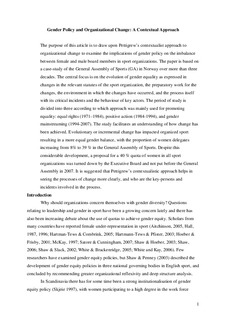| dc.contributor.author | Skirstad, Berit | |
| dc.date.accessioned | 2010-03-04T08:39:06Z | |
| dc.date.issued | 2009-05-12 | |
| dc.identifier.citation | Sport Management Review. 2009, 12(4), 202-216 | en |
| dc.identifier.issn | 1441-3523 | |
| dc.identifier.uri | http://hdl.handle.net/11250/170649 | |
| dc.description | I Brage finner du siste tekst-versjon av artikkelen, og den kan inneholde ubetydelige forskjeller fra forlagets pdf-versjon. Forlagets pdf-versjon finner du på www.sciencedirect.com: http://dx.doi.org/10.1016/j.smr.2009.03.003 / In Brage you'll find the final text version of the article, and it may contain insignificant differences from the journal's pdf version. The original publication is available at www.sciencedirect.com: http://dx.doi.org/10.1016/j.smr.2009.03.003 | |
| dc.description.abstract | The purpose of this article is to draw upon Pettigrew's contextualist approach to organizational change to examine the implications of gender policy on the imbalance between female and male board members in sport organizations. The paper is based on a case study of the General Assembly (GA) of Sports in Norway over more than three decades. The central focus is on the evolution of gender equality as expressed in changes in the relevant statutes of the sport organization, the preparatory work for the changes, the environment in which the changes have occurred, and the process itself with its critical incidents and the behaviour of key actors. The period of study is divided into three according to which approach was mainly used for promoting equality: equal rights (1971–1984), positive action (1984–1994), and gender mainstreaming (1994–2007). The study facilitates an understanding of how change has been achieved. Evolutionary or incremental change has impacted organized sport resulting in a more equal gender balance, with the proportion of women delegates increasing from 8% to 39% in the General Assembly of Sports. Despite this considerable development, a proposal for a 40% quota of women in all sport organizations was turned down by the Executive Board and not put before the General Assembly in 2007. It is suggested that Pettigrew's contextualistic approach helps in seeing the processes of change more clearly, and who are the key-persons and incidents involved in the process. | en |
| dc.format.extent | 102296 bytes | |
| dc.format.mimetype | application/pdf | |
| dc.language.iso | eng | en |
| dc.publisher | Elsevier | en |
| dc.subject | gender policy | en |
| dc.subject | organizational change | en |
| dc.subject | contextual approach | en |
| dc.title | Gender policy and organizational change : a contextual approach | en |
| dc.type | Peer reviewed | en |
| dc.type | Journal article | en |
| dc.subject.nsi | VDP::Social science: 200::Economics: 210 | |
| dc.subject.nsi | VDP::Social science: 200::Social science in sports: 330 | |
| dc.source.pagenumber | 202-216 | en |
| dc.source.volume | 12 | en |
| dc.source.journal | Sport Management Review | en |
| dc.source.issue | 4 | en |
